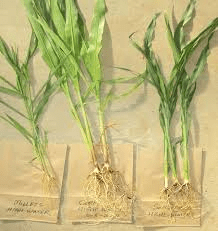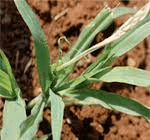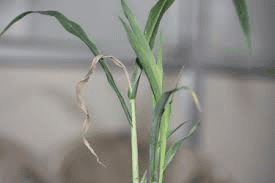Sorghum shoots are vital for the plant’s growth and productivity, encompassing all above-ground parts of the plant, including stems, leaves, and reproductive structures such as flowers and seeds. These shoots are essential for photosynthesis, nutrient transport, and reproduction, playing a significant role in the plant’s life cycle and its adaptability to various environmental conditions.
The main stem, or culm, of the sorghum plant is a prominent feature of the shoot system. It is typically tall and erect, providing structural support to the plant. The stem consists of a series of nodes and internodes, with leaves emerging from each node. Internodes are the sections of the stem between two nodes, and their length can vary depending on genetic factors and environmental conditions.
The stem is composed of vascular tissues, including xylem and phloem, which are crucial for the transport of water, minerals, and photosynthates. The xylem transports water and nutrients from the roots to the rest of the plant, while the phloem distributes the products of photosynthesis from the leaves to other parts of the plant.
Leaves are another critical component of the sorghum shoot system. They are the primary sites of photosynthesis, the process by which plants convert light energy into chemical energy.
Sorghum leaves are long, narrow, and typically have a midrib running down the center, providing structural support. The leaves are arranged alternately along the stem and are equipped with stomata, small openings that regulate gas exchange and water vapor loss. The efficiency of photosynthesis in sorghum leaves is influenced by factors such as light intensity, temperature, and water availability.
The reproductive structures of sorghum, which include the inflorescence, flowers, and seeds, are crucial for the plant’s reproduction and the production of grain. The inflorescence, commonly known as the panicle, is located at the top of the stem and consists of a central axis with numerous branches bearing small flowers.
These flowers can be either self-pollinated or cross-pollinated, leading to the development of seeds. Sorghum seeds are encased in a protective hull and are a rich source of nutrients, making them valuable for both human consumption and animal feed.
Sorghum shoots exhibit various adaptations that enable the plant to thrive in diverse environmental conditions. For instance, the leaves have a waxy cuticle that reduces water loss through evaporation, helping the plant conserve moisture in arid environments. Additionally, the plant can roll its leaves during periods of drought to reduce surface area and minimize water loss. The stem’s rigidity and strength, provided by lignin and other structural compounds, help the plant withstand strong winds and heavy rainfall.
The growth and development of sorghum shoots are influenced by several factors, including genetic traits, environmental conditions, and agronomic practices. Optimal soil fertility, adequate water supply, and proper plant spacing can enhance shoot growth and overall plant health. Conversely, stress conditions such as nutrient deficiencies, drought, and pest infestations can negatively impact shoot development and reduce crop yield.
Sorghum shoots also have significant economic and ecological importance. The grain produced by sorghum plants is a staple food in many parts of the world, particularly in arid and semi-arid regions. Sorghum is also used for animal feed, biofuel production, and industrial applications. Furthermore, sorghum plants contribute to soil health by improving soil structure and increasing organic matter content through the decomposition of plant residues.
Sorghum shoots are integral to the plant’s ability to perform photosynthesis, transport nutrients, and reproduce. Their structure and function are adapted to support growth and productivity in a variety of environmental conditions. Understanding the biology and ecology of sorghum shoots can inform agricultural practices aimed at improving crop yield, sustainability, and resilience.
The Economic Importance and Uses of Sorghum Shoots

1. Forage Crop: Sorghum shoots are a valuable forage crop for livestock, providing essential nutrients.
2. Silage Production: Sorghum shoots can be fermented to produce silage, which is used as livestock feed during the non-growing season.
3. Human Consumption: Young sorghum shoots are consumed as a leafy vegetable in some cultures, offering a source of vitamins and minerals.
4. Biofuel Production: Sorghum shoots can be processed into biofuels such as ethanol through fermentation.
5. Biomass Energy: The high biomass yield of sorghum shoots makes them a good source for biomass energy production.
6. Paper Production: The fibers in sorghum shoots can be used in paper manufacturing, reducing the reliance on wood pulp.
7. Soil Mulch: Chopped sorghum shoots can be used as mulch to retain soil moisture and suppress weeds.
8. Animal Bedding: Processed sorghum shoots can be used as bedding material for livestock.
9. Composting: Sorghum shoots decompose well, contributing to organic compost.
10. Erosion Control: The dense growth of sorghum shoots helps in controlling soil erosion by providing ground cover.
11. Phytoremediation: Sorghum shoots are used in phytoremediation to extract pollutants from the soil.
12. Green Manure: Sorghum shoots can be plowed back into the soil as green manure to enhance soil fertility.
13. Organic Farming: Sorghum shoots are used in organic farming systems as a cover crop to improve soil health.
14. Crop Rotation: Including sorghum shoots in crop rotation helps in breaking pest and disease cycles, improving overall crop health.
15. Intercropping: Sorghum shoots are beneficial in intercropping systems, enhancing biodiversity and soil health.
16. Silvopasture Systems: Sorghum shoots are used in silvopasture systems, where they are grown alongside trees to provide forage for livestock.
17. Fodder Banks: Sorghum shoots are stored in fodder banks to ensure a steady supply of livestock feed during dry seasons.
18. Biochar Production: Sorghum shoots can be converted into biochar, which is used to improve soil health and fertility.
Read Also: 7 Medicinal Health Benefits of Gynostemma pentaphyllum (Southern Ginseng)
The Products and By-products That Can Be Derived From Sorghum Shoots

1. Ethanol: Produced by fermenting the sugars in sorghum shoots, used as a biofuel.
2. Silage: Fermented sorghum shoots are used as livestock feed during the non-growing season.
3. Green Vegetables: Young sorghum shoots are consumed as leafy vegetables, offering nutritional benefits.
4. Biomass Pellets: Sorghum shoots can be processed into biomass pellets for energy production.
5. Paper: The fibers in sorghum shoots can be processed into paper.
6. Mulch: Chopped sorghum shoots can be used as mulch to retain soil moisture and suppress weeds.
7. Compost: Sorghum shoots decompose into rich compost, providing nutrients for plants.
8. Animal Bedding: Processed sorghum shoots can be used as comfortable bedding material for livestock.
9. Biochar: Produced by pyrolyzing sorghum shoots, biochar is used to enhance soil fertility and sequester carbon.
10. Phytoremediation Agents: Sorghum shoots can be used to extract pollutants from the soil in phytoremediation processes.
11. Green Manure: Sorghum shoots can be plowed back into the soil to improve soil health and fertility.
12. Fodder: Sorghum shoots are used as fresh fodder for livestock.
13. Erosion Control Mats: Sorghum shoots can be woven into mats to prevent soil erosion.
14. Soil Amendments: The biomass from sorghum shoots can be used as soil amendments to improve soil structure and fertility.
15. Organic Fertilizer: Decomposed sorghum shoots add organic matter and nutrients to the soil.
16. Compost Tea: Sorghum shoots can be used to make compost tea, a liquid fertilizer for plants.
17. Hydroponic Growth Medium: Sorghum shoots can be processed into a growth medium for hydroponic systems.
Read Also: 7 Medicinal Health Benefits of Sandalwood (Santalum album)
Frequently Asked Questions (FAQ’s) About Sorghum Shoots

1. What are sorghum shoots?
Sorghum shoots are the young, above-ground parts of the sorghum plant, including the leaves and stems.
2. How are sorghum shoots used in livestock feed?
They are used fresh or fermented as silage to provide essential nutrients for livestock.
3. Can sorghum shoots be eaten by humans?
Yes, young sorghum shoots are consumed as a leafy vegetable in some cultures.
4. How do sorghum shoots contribute to biofuel production?
They can be processed into ethanol through fermentation.
5. Are sorghum shoots useful for soil health?
Yes, they can be used as mulch, green manure, and compost to improve soil fertility and structure.
6. What role do sorghum shoots play in erosion control?
The dense growth helps stabilize the soil and prevent erosion.
7. Can sorghum shoots be used in organic farming?
Yes, they are used as cover crops and green manure in organic farming systems.
8. How are sorghum shoots processed into biochar?
They are pyrolyzed in the absence of oxygen to produce biochar, which enhances soil health.
9. Are sorghum shoots suitable for intercropping?
Yes, they are beneficial in intercropping systems, improving biodiversity and soil health.
10. What products can be derived from sorghum shoots?
Products include ethanol, silage, biomass pellets, paper, mulch, compost, and biochar.
Read Also: Waste Management Startups: The Future of Sustainable Waste Management

